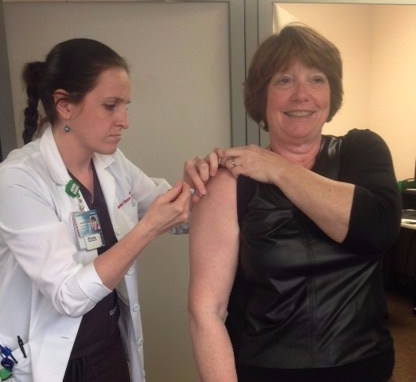
To highlight the importance of immunization across the lifespan, NFID is hosting a 2017 National Immunization Awareness Month (NIAM) blog relay, featuring a weekly guest post from an immunization champion/organization. Each week of #NIAM17 focuses on a different stage of the lifespan.
 Special thanks to NFID Board member Ruth M. Carrico, PhD, RN, associate professor of medicine, Division of Infectious Diseases and founding associate director at the University of Louisville Global Health Center, for this guest blog post focused on tips to increase healthcare professional (HCP) vaccination rates.
Special thanks to NFID Board member Ruth M. Carrico, PhD, RN, associate professor of medicine, Division of Infectious Diseases and founding associate director at the University of Louisville Global Health Center, for this guest blog post focused on tips to increase healthcare professional (HCP) vaccination rates.
Immunization is an essential component of disease prevention and control. Preventing healthcare-associated transmission of infectious diseases protects patients, healthcare professionals (HCPs), their families, and their communities.
Those who work directly with patients or handle materials that may spread infection should be vaccinated in order to reduce the chances of acquiring or spreading vaccine-preventable diseases. The Centers for Disease Control and Prevention (CDC) has published a list of recommended vaccines for healthcare workers. These recommendations are relevant for healthcare professionals (HCPs) providing care in any healthcare setting.
Here are six important tips to increasing HCP vaccination rates:
1. Have a vaccination policy in place. The most effective way to ensure that HCPs receive recommended vaccinations is to have a written policy. If a healthcare facility receives federal funding for the provision of patient care (e.g., Medicare/Medicaid), then CMS standards require that an immunization program is in place. The same is true for accreditation standards that outline care expectations in acute and long-term care facilities. Clearly stating this expectation in a written policy is also a way to demonstrate the facility’s commitment to the provision of safe care for all patients in all healthcare settings.
2. Educate… Educate… Educate.  Make sure HCPs know why immunization is so important. HCPs should be aware of the risks of disease as well as the risks of spreading disease to patients. As healthcare professionals, they must talk-the-talk and walk-the-walk. All HCPs need to know that vaccines are safe and effective tools for disease prevention.
Make sure HCPs know why immunization is so important. HCPs should be aware of the risks of disease as well as the risks of spreading disease to patients. As healthcare professionals, they must talk-the-talk and walk-the-walk. All HCPs need to know that vaccines are safe and effective tools for disease prevention.
3. Increase awareness about vaccination rates. Communicating with HCPs about their own vaccination status can be more challenging than expected. Research published by CDC stated that early season 2016–2017 flu vaccination coverage among HCPs was 66.7%, leaving plenty of room for improvement. Additionally, vaccination rates of HCPs who work in long-term care settings, those in close contact with individuals at greater risk of flu and flu-related complications, was much worse (55.1%). Reviewing NFID vaccine communication tips can result in a more effective conversation, even with those HCPs who may be vaccine-hesitant. Remember to include patients and visitors in immunization awareness efforts, as they can be important advocates. And patients have the right to expect that the healthcare professionals caring for them will do so safely.
4. Make it easy. Access to immunization should be easy. Regularly scheduled clinics, mobile clinics, or walk-in clinic hours can increase vaccination rates for both HCPs and patients!
 5. Lead by example. Leadership should model the behavior desired in others. Share photos of leaders getting vaccinated in newsletters and posters around your practice. Pair photos with an announcement of clinic hours to send a clear message that immunization is a priority. Remember that leadership does not reside solely at the executive level. There are influential leaders present in every area. Identify them and empower them to serve as local immunization champions.
5. Lead by example. Leadership should model the behavior desired in others. Share photos of leaders getting vaccinated in newsletters and posters around your practice. Pair photos with an announcement of clinic hours to send a clear message that immunization is a priority. Remember that leadership does not reside solely at the executive level. There are influential leaders present in every area. Identify them and empower them to serve as local immunization champions.
6. Provide incentives. No one thing will be effective for all individuals but there are small ways to motivate team members to get vaccinated. Try a contest between departments – first to reach 100% for a special breakfast. Celebrate areas within the facility achieving high rates of HCP immunization. Provide feedback regarding vaccination rates so that all within the facility have the opportunity to do their share in promoting and improving immunization rates. Be sure to identify and highlight strategies that have worked so that they can be repeated and expanded. Make successful immunization programs the expected and the norm.
To learn more about current recommendations and strategies to increase HCP vaccination rates, be sure to view Occupational Health: Vaccination in the Workplace (on-demand CME webinar) and register to attend the NFID Fall 2017 Clinical Vaccinology Course scheduled for November 3-4, 2017 in Bethesda, MD. Register before 9/25/17 to save $100 on registration fees. For more information, visit www.nfid.org/cvc.
To join the conversation, follow NFID (@nfidvaccines) and Ruth Carrico (@RuthCarrico2) on Twitter using the hashtag #NIAM17, like NFID on Facebook, follow NFID on Instagram, join the NFID Linkedin Group, and subscribe to NFID Updates.
Related Posts

News Round-Up: Infectious Disease Threats
According to NFID website poll, there are several worrisome infectious disease threats. Read recent news on topics of greatest concern, including avian influenza (bird flu), measles, and respiratory syncytial virus (RSV) …

Vaccines and Heart Health: A Vital Connection
Heart disease can increase the risk of serious or fatal complications from respiratory diseases including COVID-19, flu, and RSV

Harnessing the Power of Local Data
NFID dashboard aims to empower stakeholders with hyperlocal data to increase US adult respiratory vaccine uptake
